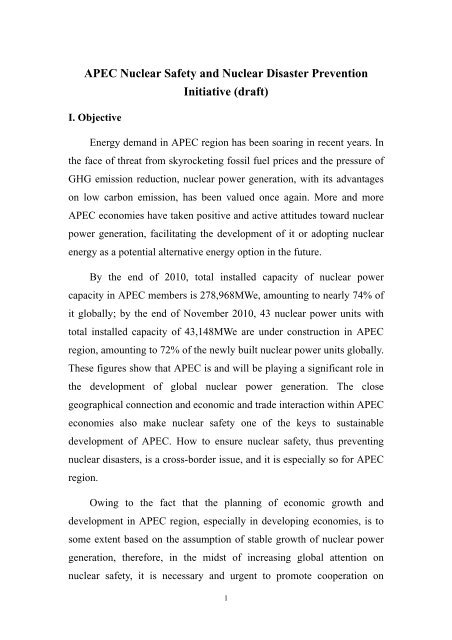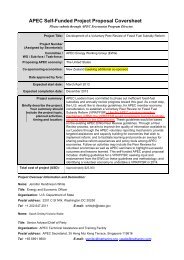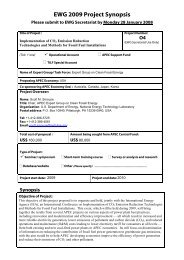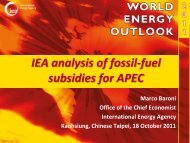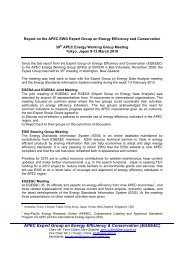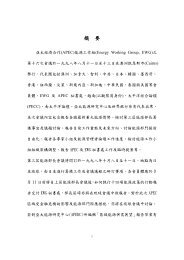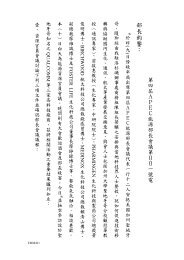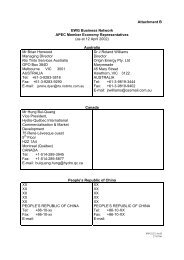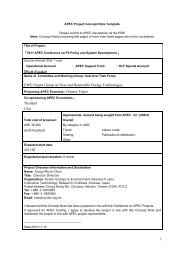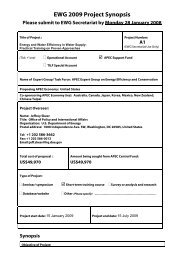APEC Nuclear Safety and Nuclear Disaster Prevention Initiative (draft)
APEC Nuclear Safety and Nuclear Disaster Prevention Initiative (draft)
APEC Nuclear Safety and Nuclear Disaster Prevention Initiative (draft)
Create successful ePaper yourself
Turn your PDF publications into a flip-book with our unique Google optimized e-Paper software.
<strong>APEC</strong> <strong>Nuclear</strong> <strong>Safety</strong> <strong>and</strong> <strong>Nuclear</strong> <strong>Disaster</strong> <strong>Prevention</strong><strong>Initiative</strong> (<strong>draft</strong>)I. ObjectiveEnergy dem<strong>and</strong> in <strong>APEC</strong> region has been soaring in recent years. Inthe face of threat from skyrocketing fossil fuel prices <strong>and</strong> the pressure ofGHG emission reduction, nuclear power generation, with its advantageson low carbon emission, has been valued once again. More <strong>and</strong> more<strong>APEC</strong> economies have taken positive <strong>and</strong> active attitudes toward nuclearpower generation, facilitating the development of it or adopting nuclearenergy as a potential alternative energy option in the future.By the end of 2010, total installed capacity of nuclear powercapacity in <strong>APEC</strong> members is 278,968MWe, amounting to nearly 74% ofit globally; by the end of November 2010, 43 nuclear power units withtotal installed capacity of 43,148MWe are under construction in <strong>APEC</strong>region, amounting to 72% of the newly built nuclear power units globally.These figures show that <strong>APEC</strong> is <strong>and</strong> will be playing a significant role inthe development of global nuclear power generation. The closegeographical connection <strong>and</strong> economic <strong>and</strong> trade interaction within <strong>APEC</strong>economies also make nuclear safety one of the keys to sustainabledevelopment of <strong>APEC</strong>. How to ensure nuclear safety, thus preventingnuclear disasters, is a cross-border issue, <strong>and</strong> it is especially so for <strong>APEC</strong>region.Owing to the fact that the planning of economic growth <strong>and</strong>development in <strong>APEC</strong> region, especially in developing economies, is tosome extent based on the assumption of stable growth of nuclear powergeneration, therefore, in the midst of increasing global attention onnuclear safety, it is necessary <strong>and</strong> urgent to promote cooperation on1
nuclear safety <strong>and</strong> nuclear disaster prevention within the <strong>APEC</strong>framework <strong>and</strong> to enhance sharing <strong>and</strong> dissemination of relevantknowledge <strong>and</strong> experience.For the past few decades, multilateral organizations, such asInternational Atomic Energy Agency (IAEA), OECD <strong>Nuclear</strong> EnergyAgency (NEA), <strong>and</strong> World Association of <strong>Nuclear</strong> Operators (WANO),have developed universal st<strong>and</strong>ards <strong>and</strong> regulations concerning nuclearsafety <strong>and</strong> non-proliferation, nuclear waste disposal <strong>and</strong> management,radiation prevention, disaster emergency response, nuclear technologydevelopment, nuclear energy facility st<strong>and</strong>ards, <strong>and</strong> operation <strong>and</strong> reviewof nuclear power plants. <strong>Nuclear</strong> safety networks have also beenestablished. It is expected that new, stricter <strong>and</strong> more reliable safetyst<strong>and</strong>ards <strong>and</strong> regulations will be developed to enhance the capacity ofnuclear power plants in response to compound disasters.<strong>APEC</strong> Energy Ministerial Declaration of 2010 acknowledged thatcooperation among member economies <strong>and</strong> with relevant multilateralorganizations can help the constructions of new nuclear power plants. Inthis regard, based on the close cooperation that have been built between<strong>APEC</strong> <strong>and</strong> major international energy organizations in the past few years,this <strong>Initiative</strong> will exp<strong>and</strong> cross-organizational energy cooperation tonuclear energy fields. In order to explore best solution to the challengesof nuclear safety <strong>and</strong> sustainable development encountered by <strong>APEC</strong>, the<strong>Initiative</strong> will promote regular dialogues <strong>and</strong> collaborations between<strong>APEC</strong> <strong>and</strong> relevant multilateral organizations. In addition to the dialogues<strong>and</strong> cooperation with other organizations, EWG <strong>and</strong> EPWG shoulddevelop closer contact <strong>and</strong> cooperation on this issue based on theirindividual expertise <strong>and</strong> responsibility within the framework of <strong>APEC</strong>.2
Meanwhile, in order to strengthen the conformity of <strong>APEC</strong> membereconomies on practice <strong>and</strong> regulation of nuclear safety <strong>and</strong> nucleardisaster prevention, it is necessary to pay greater attention to nuclearsafety related issues such as governance, nuclear regulation, disasterprevention mechanism, information disclosure <strong>and</strong> public communication.Thus, this <strong>Initiative</strong> will establish a framework <strong>and</strong> a platform for <strong>APEC</strong>cooperation on nuclear safety <strong>and</strong> disaster prevention to promote theexperience sharing <strong>and</strong> knowledge dissemination with regard to thegovernance <strong>and</strong> establishment of system. It will also conduct regularreviews on nuclear disaster emergency preparedness mechanism tostrengthen the existing information reporting <strong>and</strong> the support <strong>and</strong> dispatchfunctions in this region.In addition, this <strong>Initiative</strong> will also encourage cooperation on nuclearsafety <strong>and</strong> disaster prevention to cover not only professionals but alsonon-professionals, for example, disaster prevention training <strong>and</strong> exercisesfor government staff <strong>and</strong> the public. This initiative is also expected toconduct comprehensive training, information cooperation <strong>and</strong> experiencesharing on public education <strong>and</strong> communication of nuclear safety.In summary, the objective of this <strong>Initiative</strong> is to strengthen thecapacity building of nuclear safety <strong>and</strong> disaster prevention in <strong>APEC</strong>economies from a preventive perspective, <strong>and</strong> to ensure zero probabilityof any nuclear disaster in <strong>APEC</strong> region. It also aims to assist inpublic-private nuclear safety education <strong>and</strong> communication in membereconomies to jointly promote a safe, reliable <strong>and</strong> sustainable environmentfor nuclear utilization.3
II. Background1. The <strong>APEC</strong> Framework for Capacity Building <strong>Initiative</strong> onEmergency Preparedness was endorsed in 1998; in the same yearAustralia led the establishment of the <strong>APEC</strong> Virtual Task Force onEmergency Preparedness (VTFEP) as a communication platform. In 2005,the <strong>APEC</strong> Strategy on Response to <strong>and</strong> Preparedness for Natural<strong>Disaster</strong>s <strong>and</strong> Emergencies was passed, <strong>and</strong> VTFEP was transformed intothe Task Force on Emergency Preparedness (TFEP) under the frameworkof SOM to encourage capacity building of disaster management <strong>and</strong>relevant international cooperation. In June 2010 TFEP was upgraded tothe Emergency Preparedness Working Group (EPWG), a permanentworking group that is currently co-chaired by Australia <strong>and</strong> Indonesia.2. The Sydney <strong>APEC</strong> Leader’s Declaration of 2007 emphasized thatthe important role for low <strong>and</strong> zero emissions energy sources <strong>and</strong>technologies, <strong>and</strong> it stated that for those economies which choose to do so,the use of nuclear energy, in a manner ensuring nuclear safety, security<strong>and</strong> non-proliferation in particular its safeguards, can also contribute.3. The Darwin Declaration of 2007 encouraged the development ofcleaner <strong>and</strong> more efficient power generation technologies, includingrenewables, clean coal, natural gas/LNG, <strong>and</strong> for interested economies,nuclear technologies; it also encouraged interested <strong>APEC</strong> economies tojoin the EWG Ad-hoc Group on <strong>Nuclear</strong> Technologies <strong>and</strong> to ensure thatthe safety, security, seismic, health <strong>and</strong> waste h<strong>and</strong>ling aspects, includingtrans-border effects, of civilian nuclear energy, are adequately addressed.4. The Fukui Declaration of 2010 expressed that.We therefore need to assess the emissions reduction potential ofnuclear power in <strong>APEC</strong>. Solid financial frameworks as well as4
cooperation among member economies <strong>and</strong> with relevant multilateralorganizations, can help to support new nuclear power plant construction.The declaration also instructed the EWG to consider possiblecooperation with other relevant organizations such as the InternationalAtomic Energy Agency (IAEA), including its Asian <strong>Nuclear</strong> <strong>Safety</strong>Network (ANSN).that5. The Yokohama <strong>APEC</strong> Leader’s Declaration of 2010 determined.We will promote deployment of low-emission power sources -renewable, nuclear, <strong>and</strong> fossil fuels with carbon capture <strong>and</strong> storage - tomake our energy supply cleaner.6. In the Medium Term Work Plan (2010-2015) of EWG, interestedeconomies <strong>and</strong> OECD <strong>Nuclear</strong> Energy Agency will conduct <strong>Nuclear</strong>Power Emissions Reduction Potential Study to improve underst<strong>and</strong>ing ofthe potential of nuclear power to contribute to greenhouse gas emissionsreduction goals in <strong>APEC</strong>.5
III. Activities to be advancedThis <strong>Initiative</strong> shall be advanced by interested economies, includingthose who have already possessed or planned to develop nuclear powergeneration, <strong>and</strong> those who may develop nuclear power generation in thefuture. By means of workshops, exercises, personnel training <strong>and</strong>information sharing, this <strong>Initiative</strong> will conduct experience sharing <strong>and</strong>cooperation to strengthen <strong>APEC</strong>’s capacity for emergency preparedness.Planned activities are as follow:1. Promotion of cross-organizational cooperation• Collaboration between <strong>APEC</strong> EWG <strong>and</strong> EPWG to strengthen<strong>APEC</strong>’s capacity of emergency preparedness with regard tonuclear energy.• Collaboration on nuclear safety between <strong>APEC</strong> <strong>and</strong>nuclear-related organizations such as Asian <strong>Nuclear</strong> <strong>Safety</strong>Network (ANSN) of IAEA <strong>and</strong> <strong>Nuclear</strong> Energy Agency (NEA)of OECD to strengthen the safety of nuclear energy utilization inmember economies.2. Promotion of information sharing• Workshop on <strong>APEC</strong> nuclear safety <strong>and</strong> disaster prevention toshare member economies’ regulation framework of nuclear safety,disaster prevention mechanism <strong>and</strong> disaster response approaches<strong>and</strong> experiences.• Workshop on public education <strong>and</strong> communication informationof <strong>APEC</strong> nuclear safety <strong>and</strong> disaster prevention for membereconomies to exchange respective approaches <strong>and</strong> experiences onnuclear safety information disclosure <strong>and</strong> public communication.6
• Establishment of a web-based platform to collect relevantinformation on nuclear safety <strong>and</strong> disaster prevention for membereconomies’ sharing <strong>and</strong> discussion.3. Dissemination of knowledge• Personnel training <strong>and</strong> education of nuclear safety regulators in<strong>APEC</strong> region.• Study on Best Practices of <strong>APEC</strong> nuclear safety informationdissemination system <strong>and</strong> preventive measures.IV. Benefits to <strong>APEC</strong>Through information sharing, knowledge dissemination <strong>and</strong>cross-organizational collaboration, this <strong>Initiative</strong> aims at assistingeconomies in their capacity building of nuclear safety <strong>and</strong> nuclear disasterprevention, <strong>and</strong> to promote conformity of <strong>APEC</strong>’s operation towardsnuclear safety <strong>and</strong> disaster prevention. This <strong>Initiative</strong> also seeks to help topromote economies’ public education <strong>and</strong> communication of nuclearsafety <strong>and</strong> to contribute to energy security <strong>and</strong> sustainable developmentof <strong>APEC</strong>.7


